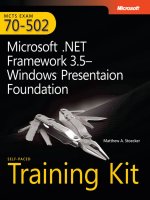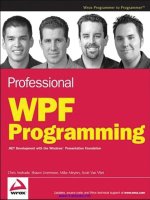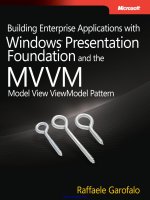WPF Programming: .NET Development with the Windows® Presentation Foundation pot
Bạn đang xem bản rút gọn của tài liệu. Xem và tải ngay bản đầy đủ của tài liệu tại đây (13.45 MB, 482 trang )
www.it-ebooks.info
Professional
WPF Programming:
.NET Development with the
Windows
®
Presentation
Foundation
Chris Andrade,
Shawn Livermore,
Mike Meyers,
Scott Van Vliet
01_041802 ffirs.qxp 4/2/07 5:16 PM Page iii
www.it-ebooks.info
01_041802 ffirs.qxp 4/2/07 5:16 PM Page ii
www.it-ebooks.info
Professional
WPF Programming:
.NET Development with the
Windows
®
Presentation
Foundation
01_041802 ffirs.qxp 4/2/07 5:16 PM Page i
www.it-ebooks.info
01_041802 ffirs.qxp 4/2/07 5:16 PM Page ii
www.it-ebooks.info
Professional
WPF Programming:
.NET Development with the
Windows
®
Presentation
Foundation
Chris Andrade,
Shawn Livermore,
Mike Meyers,
Scott Van Vliet
01_041802 ffirs.qxp 4/2/07 5:16 PM Page iii
www.it-ebooks.info
Professional WPF Programming: .NET Development with the
Windows
®
Presentation Foundation
Published by
Wiley Publishing, Inc.
10475 Crosspoint Boulevard
Indianapolis, IN 46256
www.wiley.com
Copyright © 2007 by Wiley Publishing, Inc., Indianapolis, Indiana
Published simultaneously in Canada
ISBN: 978-0-470-04180-2
Manufactured in the United States of America
10 9 8 7 6 5 4 3 2 1
Library of Congress Cataloging-in-Publication Data is available from the publisher.
No part of this publication may be reproduced, stored in a retrieval system or transmitted in any form or by
any means, electronic, mechanical, photocopying, recording, scanning or otherwise, except as permitted
under Sections 107 or 108 of the 1976 United States Copyright Act, without either the prior written permis-
sion of the Publisher, or authorization through payment of the appropriate per-copy fee to the Copyright
Clearance Center, 222 Rosewood Drive, Danvers, MA 01923, (978) 750-8400, fax (978) 646-8600. Requests to
the Publisher for permission should be addressed to the Legal Department, Wiley Publishing, Inc., 10475
Crosspoint Blvd., Indianapolis, IN 46256, (317) 572-3447, fax (317) 572-4355, or online at
ey
.com/go/permissions
.
LIMIT OF LIABILITY/DISCLAIMER OF WARRANTY: THE PUBLISHER AND THE AUTHOR MAKE NO
REPRESENTATIONS OR WARRANTIES WITH RESPECT TO THE ACCURACY OR COMPLETENESS OF
THE CONTENTS OF THIS WORK AND SPECIFICALLY DISCLAIM ALL WARRANTIES, INCLUDING
WITHOUT LIMITATION WARRANTIES OF FITNESS FOR A PARTICULAR PURPOSE. NO WARRANTY
MAY BE CREATED OR EXTENDED BY SALES OR PROMOTIONAL MATERIALS. THE ADVICE AND
STRATEGIES CONTAINED HEREIN MAY NOT BE SUITABLE FOR EVERY SITUATION. THIS WORK IS
SOLD WITH THE UNDERSTANDING THAT THE PUBLISHER IS NOT ENGAGED IN RENDERING
LEGAL, ACCOUNTING, OR OTHER PROFESSIONAL SERVICES. IF PROFESSIONAL ASSISTANCE IS
REQUIRED, THE SERVICES OF A COMPETENT PROFESSIONAL PERSON SHOULD BE SOUGHT.
NEITHER THE PUBLISHER NOR THE AUTHOR SHALL BE LIABLE FOR DAMAGES ARISING HERE-
FROM. THE FACT THAT AN ORGANIZATION OR WEBSITE IS REFERRED TO IN THIS WORK AS A
CITATION AND/OR A POTENTIAL SOURCE OF FURTHER INFORMATION DOES NOT MEAN THAT
THE AUTHOR OR THE PUBLISHER ENDORSES THE INFORMATION THE ORGANIZATION OR
WEBSITE MAY PROVIDE OR RECOMMENDATIONS IT MAY MAKE. FURTHER, READERS SHOULD BE
AWARE THAT INTERNET WEBSITES LISTED IN THIS WORK MAY HAVE CHANGED OR DISAP-
PEARED BETWEEN WHEN THIS WORK WAS WRITTEN AND WHEN IT IS READ.
For general information on our other products and services please contact our Customer Care Department
within the United States at (800) 762-2974, outside the United States at (317) 572-3993 or fax (317) 572-4002.
Trademarks: Wiley, the Wiley logo, Wrox, the Wrox logo, Programmer to Programmer, and related trade
dress are trademarks or registered trademarks of John Wiley & Sons, Inc. and/or its affiliates, in the United
States and other countries, and may not be used without written permission. All other trademarks are the
property of their respective owners. Wiley Publishing, Inc., is not associated with any product or vendor
mentioned in this book.
Wiley also publishes its books in a variety of electronic formats. Some content that appears in print may not
be available in electronic books.
01_041802 ffirs.qxp 4/2/07 5:16 PM Page iv
www.it-ebooks.info
About the Authors
Chris Andrade is a Principal with Novera Consulting, a Microsoft Certified Partner specializing in
enterprise architecture and development with .NET and Microsoft server technology. Chris devotes most
of his time to assisting companies in applying Microsoft technologies to improve their business pro-
cesses and operations. Chris has worked within a diverse range of business verticals, including automo-
tive, healthcare, and mortgage. Chris also takes active participation within the local developer
community, speaking and presenting along the west coast whenever possible.
Shawn Livermore (MCAD, MCSD, PMP) [shawnlivermore.blogspot.com] has been architecting and
developing Microsoft-based solutions for nearly a decade. Shawn has been consulting as an enterprise
and solutions architect for Fortune 500 clientele within highly visible enterprise implementations. His
range of technical competence stretches across platforms and lines of business, but he specializes in
Microsoft .NET enterprise application architectures and Microsoft server-based product integrations.
Shawn lives in the Southern California area with his beautiful wife Shantell and amazing daughter
Elexzandreia. Shawn also enjoys beating his friend Jason at air hockey, basketball, baseball, football,
arcade games, cards, billiards, ping pong, shuffleboard, trivia, golf, racquetball, dirt bike races, cross-
country skiing and pretty much any other sport in existence. Shawn would like to once again remind
Jason, “Who’s your daddy?”
Mike Meyers is president of Novera Consulting Inc, a software development and consulting firm spe-
cializing in custom application development utilizing the .NET platform and Microsoft server technol-
ogy. Based in Orange County, California, Mike’s company is focused on providing solutions based on
Microsoft platforms and technology to companies spanning multiple industries. Mike has worked in a
number of industries, including mortgage, healthcare, and various ecommerce ventures as developer,
architect, and project manager. When he’s not writing code, Mike is active mountain biking in southern
California, hiking with his four-legged Labrador Dakota or playing music with friends.
Scott Van Vliet is an accomplished Solutions Architect who has spent the past decade delivering suc-
cessful Microsoft-based solutions to his clients. Currently a Senior Manager with Capgemini, a world-
wide leader in technology consulting services, Scott has managed, architected, and developed solutions
for companies across the globe. He is also the Microsoft Delivery Leader for Capgemini’s Telecom,
Media & Entertainment practice, providing technical and engagement leadership on all Microsoft-based
projects. Scott can be reached via his Web site at />01_041802 ffirs.qxp 4/2/07 5:16 PM Page v
www.it-ebooks.info
To my wife Sena and son Ethan: for their patience, love, and understanding
during the process of writing this book. I love you both so much.
—Chris Andrade
To my best friend and life companion, Shantell, who has stuck around with
me through it all and never once doubted me. You’ve believed in me from
the beginning when we had nothing. I appreciate your friendship and your
love, and look forward to getting old and wrinkled together. Thank you for
supporting this book and the time it required.
And, of course, I am so thankful for my daughter Elexzandreia, who has
taught me so many things. Thanks for letting daddy type on the laptop
while you write me little cards and “projects.” We must have gone through
thousands of tape dispensers and construction paper packages over these
last few years. You’re an angel, and my greatest accomplishment in this life
would be to see your life flourish and grow into the woman God has
designed you to be.
—Shawn Livermore
To my parents, Richard and Linda, who have always supported my
entrepreneurial spirit, helping me to become who I am today. In particular,
I dedicate this to my father for spending 30 years with I.B.M. to support
his family and foster my interest in computers, and to my mother for
raising a handful and teaching me an appreciation for writing and the arts.
I would also like to dedicate this book to my brother Nick. No one could ask
for a better brother or friend.
—Mike Meyers
01_041802 ffirs.qxp 4/2/07 5:16 PM Page vi
www.it-ebooks.info
Credits
Senior Acquisitions Editor
Jim Minatel
Development Editor
John Sleeva
Technical Editor
Carl Daniel
Production Editor
Christine O’Connor
Copy Editor
Nancy Rapoport
Editorial Manager
Mary Beth Wakefield
Production Manager
Tim Tate
Vice President and Executive Group Publisher
Richard Swadley
Vice President and Executive Publisher
Joseph B. Wikert
Graphics and Production Specialists
Brooke Graczyk
Denny Hager
Jennifer Mayberry
Barbara Moore
Alicia B. South
Quality Control Technicians
Cynthia Fields
Brian H. Walls
Project Coordinator
Adrienne Martinez
Proofreading and Indexing
Aptara
Anniversary Logo Design
Richard Pacifico
01_041802 ffirs.qxp 4/2/07 5:16 PM Page vii
www.it-ebooks.info
01_041802 ffirs.qxp 4/2/07 5:16 PM Page viii
www.it-ebooks.info
Acknowledgments
Many thanks to the many colleagues and friends I have worked with who have contributed so much to
my life and professional development. I would especially like to thank my partner Mike Meyers for his
accountability and support, and Mickey Williams, who inspires me to never stop learning and give back
as much as I can to the community.
—Chris Andrade
I must acknowledge the Lord Jesus. My life would be a hopeless recursion without Him in charge. For
all you computer geeks out there reading these books, be advised: your search for information and
advancement in technology and science will not have any significance if your search for the Savior has
not been fulfilled. This life means nothing without a Savior, and the only true Savior is Jesus Christ. If
your logical approach to life has somehow given into the false “scientific” explanations for our existence,
then I appeal to your spirit. Be a searcher for truth in your spirit and do not stop until you fill that gap-
ing hole in your spirit. It is a need placed deep within you that only Jesus Christ can satisfy.
—Shawn Livermore
I would like to thank the members of the WPF development team who took time out of their busy day to
provide me with insight into the internals of the .NET 3.0 platform. I would like to personally thank each
of the developers who work with me on a daily basis. In particular, I would like to thank Daniel Kesler,
who gave me numerous opportunities to lead projects early in my career, and Anthony Dulkis, for tak-
ing the leap with me into the once unfamiliar world of software consulting. I would especially like to
thank Chris Andrade for asking me to participate in the writing of this book and for working tirelessly
with me on numerous projects over the years.
—Mike Meyers
First and foremost, I’d like to thank my wife, Sebrina, for her love, friendship, and unwavering support.
I must also thank my wonderful children, Chloe, Aidan, and Gabriella—your smiles help get me
through those long nights of writing and coding. I’d also like to thank my father, Tom, for his infinite
wisdom and unimpeded confidence in me; my best friend Anthony Valentino, always my partner in
crime; and my mentor Mark Borao for his guidance and leadership. Finally, a very big thank you to the
Wrox team for their understanding and support!
—Scott Van Vliet
01_041802 ffirs.qxp 4/2/07 5:16 PM Page ix
www.it-ebooks.info
01_041802 ffirs.qxp 4/2/07 5:16 PM Page x
www.it-ebooks.info
Contents
Acknowledgments ix
Introduction xix
Chapter 1: Overview of Windows Presentation Foundation 1
A Brief History of the Windows API 2
Platform Evolution 2
Introducing .NET Framework 3.0 3
Meet Windows Presentation Foundation 3
Guiding Design Principles 3
Architecture 5
XAML 15
Declarative vs. Imperative 15
Visual Design Tools 18
XamlPad 18
Microsoft Expression Blend 19
Visual Designer for Windows Presentation Foundation 20
Electric Rain ZAM 3D 21
Mobiform Aurora 22
Summary 23
Chapter 2: WPF and .NET Programming 25
Getting Started 26
Required Installations 26
Types of WPF Applications 26
My First WPF Application 27
WPF Development Concepts 29
XAML 29
The Application Object 30
Creating the User Interface 32
Handling Events 35
Working with Controls 41
Triggers 51
Language Support 58
Deployment 61
Summary 61
02_041802 ftoc.qxp 4/2/07 5:17 PM Page xi
www.it-ebooks.info
xii
Contents
Chapter 3: Anatomy of a WPF-Enabled Application 63
Project Composition 63
App.Manifest 66
AssemblyInfo.cs 66
Resources.resx 68
Settings.settings 68
MyApp.xaml 70
.NET Framework 3.0 Windows Application 71
Window1.xaml 72
XAML Browser Application 73
Page1.xaml 73
WCF Service Library 75
Class1.cs 75
WPF Custom Control Library 78
UserControl1.xaml 79
Summary 82
Chapter 4: Building a Rich UI with Microsoft Expression Blend — Part I 83
Overview 84
The Design Environment 85
Workspace Panels 86
The Artboard 87
Configuring the Environment 88
Project Structure 90
Adding a New Project File 90
Building and Deploying a Project 91
Creating Vector Objects 91
Shapes 92
Paths 93
Manipulating Objects with the Properties Panel 94
The Transform Panel 94
The Brushes Panel 95
Opacity, Transparency, and Visibility 97
Manipulating Text 98
Managing Layouts 99
UI Layout Panels 100
Other Layout Controls 103
Nesting Layout Panels 103
02_041802 ftoc.qxp 4/2/07 5:17 PM Page xii
www.it-ebooks.info
xiii
Contents
Animation 104
Timeline Sub-Panel 104
Keyframes 105
Animate an Object’s Property 106
Motion Paths 106
Triggers 107
Creating Controls 108
Templates 110
Styles 111
States 112
Importing Audio/Video Media 113
Summary 113
Chapter 5: Building a Rich UI with Microsoft Expression Blend — Part II 115
Expression Blend Workflow 116
Code Editing with Visual Studio 2005 117
Handling User Input 118
Keyboard and Mouse Classes 118
Events and Event Handling 118
Positioning 120
Hit Testing 124
The WPF Animation API 135
Animation Classes 135
Creating a Dynamic Animation Procedurally with Code 135
Programmatic Animation 139
Interacting with Storyboards 143
WPF Drawing API 145
Geometry 145
Shapes 146
Brushes 149
Summary 153
Chapter 6: Special Effects 155
Brushes 156
SolidColorBrush 156
GradientBrush 162
ImageBrush 165
DrawingBrush 167
VisualBrush 169
02_041802 ftoc.qxp 4/2/07 5:17 PM Page xiii
www.it-ebooks.info
xiv
Contents
Bitmap Effects 171
Transformations 175
TranslateTransform 178
ScaleTransform 180
SkewTransform 183
RotateTransform 186
Opacity Masks 188
Putting It All Together — Combining Effects 191
Bouncing Ball with Reflection Example 191
Animated Image Viewer Example 197
Summary 203
Chapter 7: Custom Controls 205
Overview 206
Control Base Classes 207
The UserControl Class 207
Creating a User Control 207
Data Binding in WPF 217
Binding Markup Extensions 217
Binding Modes 217
Data Templates 219
Data Conversions 221
Creating and Editing Styles 222
Specifying a Style’s Target Type 223
Inheriting and Overriding Styles 224
Style Triggers 226
Customizing Existing Controls with Templates 228
Summary 231
Chapter 8: Using WPF in the Enterprise 233
WPF Application Models 234
Standalone Applications 235
Browser-Based Applications 238
Security Considerations 247
State Management 248
Application Object 248
Isolated Storage 250
State Management Example 252
02_041802 ftoc.qxp 4/2/07 5:17 PM Page xiv
www.it-ebooks.info
xv
Contents
Navigation 258
Elements of Navigation 258
Structured Navigation 259
Navigation Topologies 269
Application Localization 286
Automatic Layout Guidelines 287
Using Grids for Flexibility 289
Localization Attributes and Comments 290
WPF Deployment Models 291
Building Applications 292
Deploying Standalone Windows Applications 294
Deploying XAML Browser Applications 295
Deploying the .NET Framework 3.0 Runtime 296
Summary 298
Chapter 9: Security 299
WPF Security Model 299
Trusted Versus Express Applications 300
Core OS Security 300
LUA 301
Virtualization 301
Sandboxing 301
Cryptography Next Generation 302
CLR Security 302
Code Access Security 303
The Critical Code Methodology 311
Verification 313
Microsoft Internet Explorer Security 313
Zone Restrictions 313
XBAP Sandbox Workarounds 314
XAML Browser Application Security 315
ClickOnce Security 323
Trusted Publishers 323
Personal Certificate File 324
.NET 3.0 Security Utilities 327
Summary 328
02_041802 ftoc.qxp 4/2/07 5:17 PM Page xv
www.it-ebooks.info
xvi
Contents
Chapter 10: WPF and Win32 Interop 329
Win32 User Interface Overview 330
How WPF and HWNDs Interoperate 330
Using Win32 HWNDs Inside of WPF 331
Hosting a Win32 Button in WPF 332
Using WPF in Win32 Applications 335
Adding Windows Forms Controls to WPF 337
Adding Your WindowsFormsHost in Code 337
Adding Your HwndHost in XAML 339
Adding ActiveX Controls to WPF 339
Adding the ActiveX Control in XAML 344
Adding WPF Controls to Windows Forms 345
Affecting Control Properties 349
Summary 351
Chapter 11: Advanced Development Concepts 353
WPF Architecture 354
Core Subsystems 356
WPF Threading Model 359
Desktop Window Manager 360
The WPF Framework 361
Dispatcher Object 362
DependencyObject/DependencyProperty 362
Application 363
Freezable 364
Visual 364
UIElement 370
FrameworkElement 371
Control 371
A Deeper Look at XAML 373
XAML Under the Hood 373
Manipulating XAML On-the-Fly 378
Deconstructing Window1.xaml 382
x:Class 383
XAML Markup Extensions 385
XAML and Custom Types 386
02_041802 ftoc.qxp 4/2/07 5:17 PM Page xvi
www.it-ebooks.info
xvii
Contents
WPF Multithreading 388
Single-Threaded Application Model 388
Thread Affinity and DispatcherObject 389
WPF Dispatcher 390
Working with Single-Threaded Applications 391
Asynchronous Threading 393
Windows Communication Foundation 397
Service Orientation 397
WCF Architecture 398
WCF Fundamentals 399
Building a WCF Service 402
Windows Workflow Foundation 409
Workflow Defined 410
WF Architecture 411
WF Fundamentals 411
Summary 427
Index 429
02_041802 ftoc.qxp 4/2/07 5:17 PM Page xvii
www.it-ebooks.info
02_041802 ftoc.qxp 4/2/07 5:17 PM Page xviii
www.it-ebooks.info
Introduction
This is an exciting time for developers using Microsoft technologies. A seemingly endless array of new
platforms, techniques, and tools is now available or will soon be released. The developer’s playground is
growing fast. One of the new platforms emerging from the think-tank at Microsoft is the .NET
Framework 3.0, a key component of which (and the subject of this book) is the Windows Presentation
Foundation (WPF). WPF provides both developers and designers with a unified platform for creating
rich-media applications that take full advantage of the graphics capabilities of modern PC hardware.
We’ve come a long way from the command-line interfaces of decades past. Today’s application user
expects a visually engaging and streamlined interactive experience due in part to their exposure to rich
media and content found on the Internet. WPF is all about creating a rich user interface that meets these
expectations, incorporating media of all types, such as animation, video, and audio. Furthermore,
through the use of a new markup syntax called XAML and a new suite of design tools called Microsoft
Expression Blend, developers and designers can now collaborate on projects seamlessly as never before.
Prior to WPF, designers would create graphical elements for applications and hand those elements off to
developers in the form of image files. Developers would then have to model a user interface (UI) around
them. Designers can now model UI using Expression Blend, save the design as a XAML file, and simply
hand the file off to a developer to code against in Visual Studio using WPF.
This book covers the concepts and components that make up the Windows Presentation Foundation.
You learn how to create a rich UI, exploring the various controls now available to you, and how to lever-
age the new content model that WPF provides. You explore the WPF object model as well as the new
subsystems offered in WPF, such as the dependency property system and the routed event model. You
learn how to develop and deploy WPF applications targeting both the desktop and the browser. This
book also covers the new XAML syntax, which is a markup language used to define UI in your WPF
applications, regardless of whether you are developing for a standalone Windows-based environment or
targeting the web. Additionally, you learn the basics of working with Expression Blend, the new graphi-
cal design tool offered by Microsoft.
WPF is a large platform, and we’ve tried to cover a wide range of topics in this book. Our intent is to
touch on a bit of everything WPF has to offer, so you know not only what’s provided by the platform,
but also how to utilize it. Of course, because it’s a large platform, we won’t be able to cover everything,
but we’ve tried to pick the essential concepts you’ll need to get started. We hope you find it both fun and
educational and that it provides a solid foundation for you as you venture in to the new world of rich UI
development using Windows Presentation Foundation.
Whom This Book Is For
This book is aimed primarily at .NET Framework developers who want to learn how to develop applica-
tions using Microsoft’s new presentation framework, WPF. Designers who may consider using the new
Expression Blend suite of design tools and who are seeking to understand how these tools will enhance
collaboration with developers will also find this book to be a good introduction. For new developers,
03_041802 flast.qxp 4/2/07 5:17 PM Page xix
www.it-ebooks.info
xx
Introduction
there is some value in learning the new XAML syntax, but most concepts will be too advanced. For these
readers, we suggest learning .NET 2.0 as a positive first step toward WPF.
Readers who will find this book useful include:
❑ Microsoft .NET application developers looking to learn about the new WPF platform
❑ Designers looking to gain insight into Microsoft Expression Blend and the collaboration capabil-
ities offered by WPF and the tools that support it
In addition, familiarity with the following related technologies is a strong indicator that this book is for
you:
❑ Microsoft .NET Framework
❑ C#
❑ Web Services
❑ HTML
❑ CSS
Of the preceding list, a basic understanding of the .NET Framework and C# is essential. Familiarity with
Web Services, HTML markup, and CSS concepts would be beneficial, but is not required to understand
the content of this book. Those readers without at least .NET Framework and C# knowledge should
instead refer to books such as Professional .NET Framework 2.0 (ISBN 978-0-7645-7135-0) and Professional
C# 2005 (ISBN 978-0-7645-7534-1).
Reading this book from cover to cover, in sequence, is not a requirement. We suggest reading Chapters 1
through 3 initially, to get a basic understanding of WPF and XAML. After that, skipping around through
the chapters, as interest or needs dictate, should be fine.
What This Book Covers
Professional WPF Programming provides a developer-level tutorial of WPF programming techniques, pat-
terns, and use cases.
The book begins with an overview of WPF. Questions such as “What is WPF?”, “How do I start using
WPF?” and “What does WPF have to offer me?” are answered early in the first chapter, followed swiftly
by a detailed look at the subsystems and graphical features offered by the platform.
Following the overview, you dive right into the programming techniques you need for WPF. Using
Visual Studio to create some examples, you get up-to-speed fast and start creating applications right
away. Also, you are introduced to XAML, the new markup syntax for creating a UI. XAML is actually a
separate technology from WPF, but WPF uses it extensively.
With the basic concepts and programming techniques of WPF under your belt, you take a brief journey
into the world of design tools. Microsoft now offers its own suite of compelling design tools, and you’ll
get some firsthand experience with the new Microsoft Expression Blend. Using Expression Blend, you
03_041802 flast.qxp 4/2/07 5:17 PM Page xx
www.it-ebooks.info
xxi
Introduction
create advanced UI and learn to implement styling, layout, and animation. You also see how easy it is to
save your design in XAML and then use that very same markup in Visual Studio to begin coding appli-
cation logic.
Next, you learn how to create special effects in WPF, including bitmap effects, transformations, and the
use of brush objects to get glass or reflection effects. The book demonstrates these techniques and pro-
vides a foundation for creating visually stunning elements in your applications.
Following special effects, you are introduced to custom control authoring in WPF. WPF provides a very
customizable object model that allows you to apply styles and templates to existing elements. A new
content model allows you to place almost any element inside of another element. Given these new capa-
bilities, you’re unlikely to encounter many scenarios where you need to create a custom control.
However, we “never say never,” and there may be some scenarios in which a custom control is the way
to go. This book covers the topics you should take into consideration when deciding whether to create a
custom control, as well as how to build a custom control when necessary.
Next, the book dives into developing WPF applications for the enterprise. WPF offers two flavors of
application that you can create: standalone Windows-based, or web-based. The key thing to understand
is that both models utilize the same code-base, XAML, and .NET. This means that specifying your target
hosting environment is really just a matter of tweaking project file settings and then managing deploy-
ment. This is extremely powerful stuff, and it is all covered within the enterprise topics discussed in this
book.
After you gain a good understanding of application models and deployment, you will want to under-
stand security. Security in WPF is based on the .NET 2.0 CAS security model. Security is also based on
the application model you choose and where the application will be hosted. If it is hosted in a browser,
you will need to understand the Internet Zone permission set. These topics are covered in depth.
With the basics of WPF application development, deployment, and security fully explored, the book
then dives into some more advanced concepts. One of those concepts is how to mix Win32 and WPF
code. Interoperation considerations will be covered. Hosting Win32 in WPF and the reverse is possible,
and you’ll learn how to implement this feature so that you can start incorporating WPF into your Win32
applications right away.
The book finishes with a WPF deep dive into architecture, WPF framework, XAML, and threading con-
siderations. In addition, the book covers the basics of both Windows Workflow Foundation (WF) and
Windows Communication Foundation (WCF) so that you can become familiar with the other compo-
nents of the .NET Framework 3.0. To round out your understanding of these important components, you
will build a sample WCF service and a simple WF workflow application.
How This Book Is Structured
Professional WPF Programming begins by providing some background on how and why Microsoft is shift-
ing away from the long-standing Win32 platform in the direction of WPF. This is followed by an
overview of WPF and the core components and subsystems of the platform. Next, a tour of Expression
Blend is offered, and we provide examples to show you how to build rich UI. The remaining chapters
then focus on individual topics related to WPF development. The book ends with a brief introduction to
two other components that, along with WPF, make the .NET Framework 3.0 such an important and
powerful platform.
03_041802 flast.qxp 4/2/07 5:17 PM Page xxi
www.it-ebooks.info
xxii
Introduction
The chapter-level breakdown is as follows:
❑ Chapter 1, “Overview of Windows Presentation Foundation”—This chapter explores the evo-
lution of the Windows API over the years and how this paved the way for a new platform, WPF.
You will then take a high-level tour of the WPF architecture, including the new graphics capa-
bilities and subsystems that are introduced by the platform. Additional development tools are
also introduced.
❑ Chapter 2, “WPF and .NET Programming”—This chapter walks you through the requirements
for building and running WPF applications. You also learn about the various subsystems, such
as the dependency property and routed event systems. Furthermore, you are introduced to the
controls offered by WPF, and you learn how you can modify and extend these controls using the
new constructs provided by the platform.
❑ Chapter 3, Anatomy of a WPF-Enabled Application—This chapter introduces the various
application models you can use in WPF, such as those for standalone and browser-based appli-
cations. The anatomy, which includes the files and configuration settings, will also be explored
so that you are able to get up and running quickly developing WPF applications.
❑ Chapter 4, “Building a Rich UI with Microsoft Expression Blend: Part I”—This chapter intro-
duces the new tools for designers working with WPF, specifically, Microsoft Expression Blend.
You take a tour of the design environment provided by Expression Blend and look at the project
file structure. The chapter also covers creating vector graphics, layouts, animation, and controls.
❑ Chapter 5, “Building a Rich UI with Microsoft Expression Blend: Part II”—This chapter
builds on the concepts introduced in Chapter 4. You learn about how to add interactivity to
your projects to handle user input, events, and hit testing. The chapter also provides a series of
animation examples and you are introduced to the WPF drawing API. This chapter also illus-
trates the collaboration features provided between Expression Blend and Visual Studio 2005.
❑ Chapter 6, “Special Effects”—This chapter explores the rich capabilities and special effects
offered in WPF. Brushes, bitmap effects, and transformations are all covered extensively. Using
these concepts, you can create rich UI both easily and quickly in WPF.
❑ Chapter 7, “Custom Controls”—This chapter tackles custom control development in WPF.
Because of the extensive support for templates and styles in WPF, you will likely find that your
need for custom controls will be slim. However, there are times you will need or want to create
a custom control. This chapter covers not just how to create custom controls, but also how to
determine if you can get by with using the built-in support for templates and styles because
they are such powerful tools.
❑ Chapter 8, “Using WPF in the Enterprise”—This chapter explores the many factors to consider
when building an enterprise-level application with WPF. Application models, deployment,
hosting environment, security considerations, navigation, state management, and localization
are covered thoroughly in this chapter.
❑ Chapter 9, “Security”—This chapter explores the security features of WPF. Security in WPF is pri-
marily based on the application model you choose and where your application is hosted. This
chapter covers OS security, CAS security, the Internet security sandbox, and ClickOnce security.
❑ Chapter 10, “WPF and Win32 Interop”—This chapter focuses on how your WPF application
can interoperate with existing Win32 applications. The question “Can I host my WPF applica-
tion in a Win32 application?” and vice versa will be answered. You will learn about how
HWNDS differ in WPF from Win32-based applications.
03_041802 flast.qxp 4/2/07 5:17 PM Page xxii
www.it-ebooks.info









